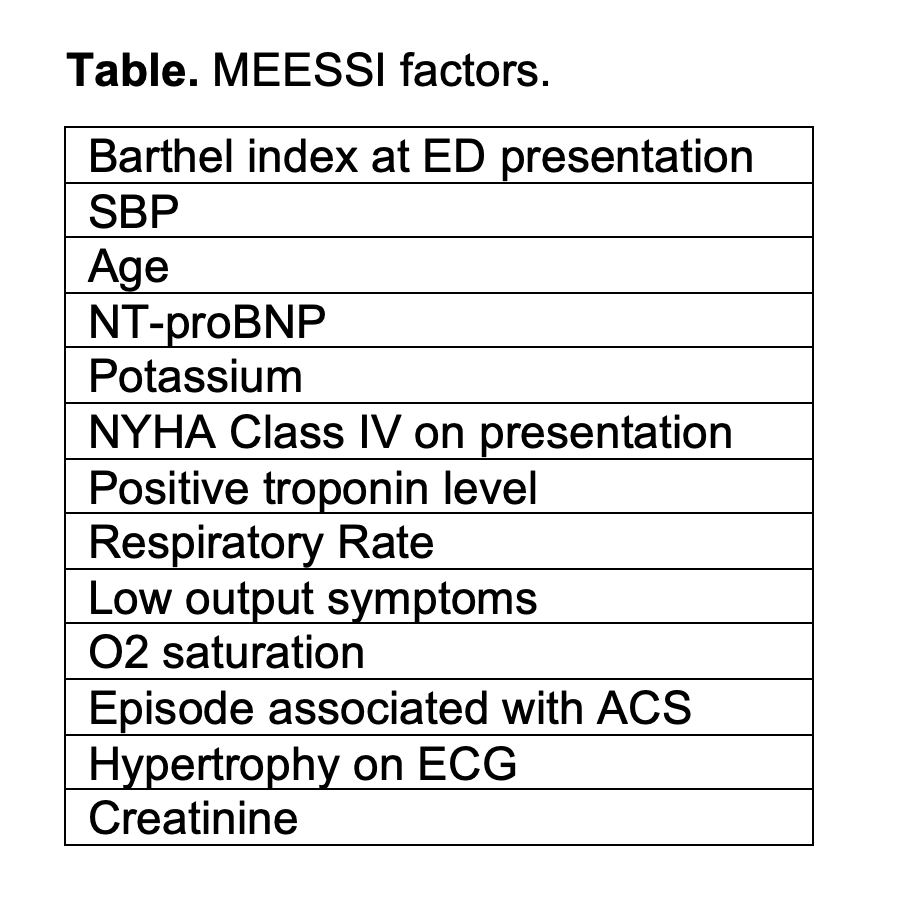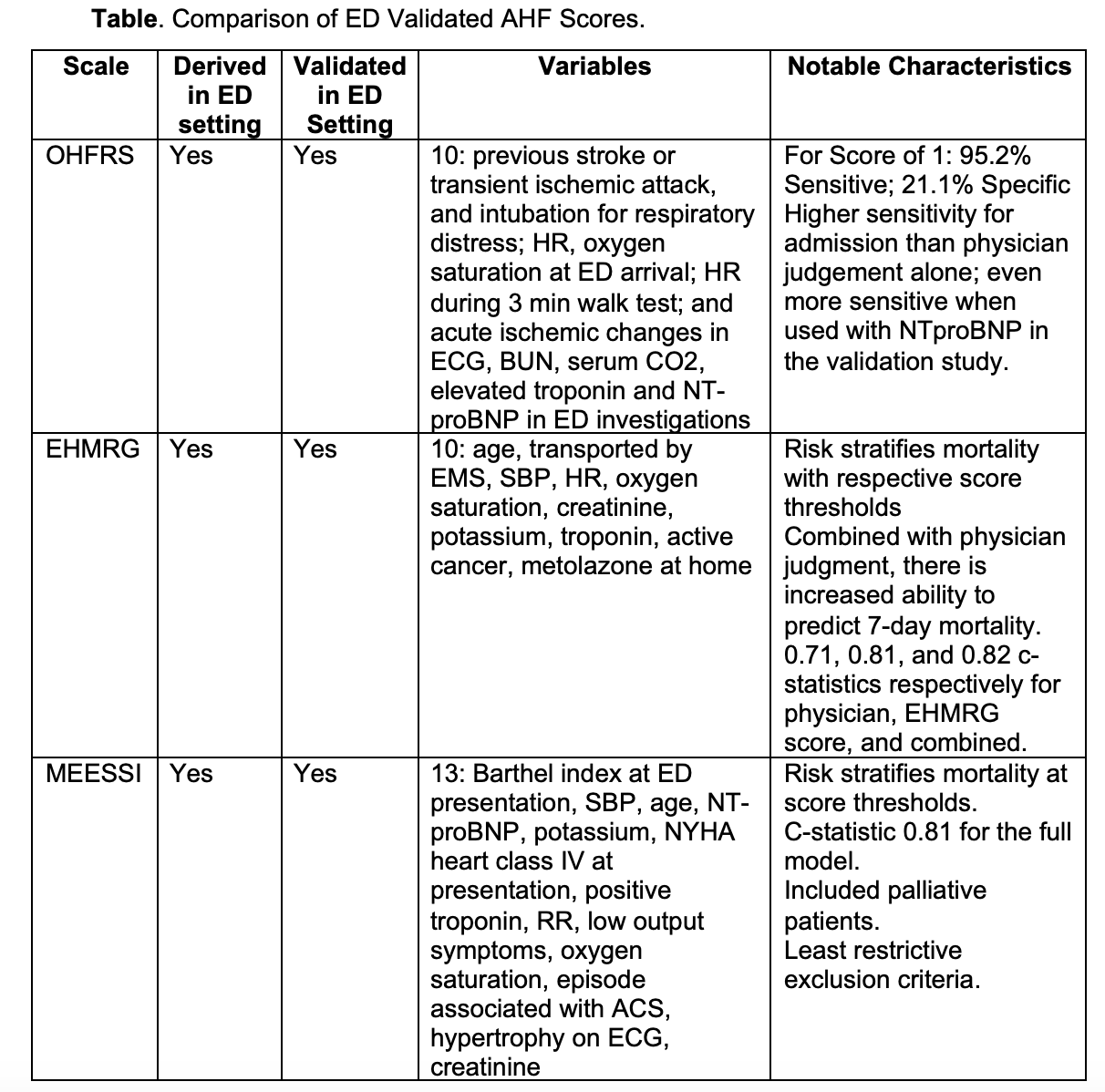Welcome back to emDOCs cast with Brit Long, MD (@long_brit). Today we have the last in the podcast series evaluating acute heart failure: disposition.
Episode 51: Acute Heart Failure Disposition
Introduction:
- Over 6.2 million patients live with HF in the U.S., and over 8 million cases of HF are projected by 2030.
- More than 90% of patients in AHF present to the emergency department (ED), and over 80% of these patients are hospitalized in the U.S.
- Mortality ranges from 4-12% for admitted patients, which may reach 25% in high-risk patients.
- Disposition can be challenging: multiple comorbidities, different precipitating factors, range of cardiac abnormalities, and presenting signs and symptoms. There are also potential issues with health literacy, self-care, and ability to follow-up for short-term re-evaluation.
- While discharge rates in the U.S. are low, they are higher in other countries (Canada) for heart failure.
ED Disposition and Adverse Event Rate
- Several studies have evaluated patient outcome after ED discharge, but they are heterogenous with important differences in outcome (mortality, hospitalization, ED revisit) and time period (7, 30, 90, 365 days) evaluated. These studies suggest that 30-day mortality after discharge range from 2.9-4%. Others show 7-day mortality less than 2%, but at 1 year this reaches 20%.
- It is not well understood if patients discharged from ED have increased rates of adverse events compared to those admitted to the hospital, and comparing these studies is difficult.
- Return visits to the ED after discharge range between 20-35% within 30 days.
- There are few high-quality data on differences in those discharged versus admitted, with multiple confounders
Risk Stratification and Impact on Disposition
- There are consensus guidelines on diagnosis and management of AHF exacerbation, but there are few recommendations on which patients may be discharged. A score may be able to risk stratify those with AHF and improve ED disposition decision making.
- Multiple challenges with these first scores: several were derived and validated in hospitalized patients, not the ED. These were also mostly retrospective based on administrative databases. These scores did not evaluate patient status after ED management, and the majority of these scores predict mortality alone, excluding outcomes such as need for admission, symptom relapse, ED revisit, intubation, and/or myocardial infarction.
Acute HF – New Onset and Decompensated Chronic HF
- One third of AHF patients have no prior history of HF.
- Patients who are presenting with new onset AHF should be admitted and require further evaluation with comprehensive echocardiogram, monitoring for dysrhythmias, and potential angiography if ischemia is present.
- Medication initiation and optimization are also needed before discharge.
- If known HF but acute decompensation, search for underlying etiology, such as acute or chronic valvular dysfunction, ACS, and dysrhythmia.
- Must also consider the pace of decompensation, as acute, sudden exacerbation indicates a more serious cause as compared to gradual, progressive decompensation. Another important medical issue to consider is the degree of chronic dysfunction of the heart (severe chronic dysfunction versus less severe) and the degree of comorbidities and end organ injuries.
- Other than patients with new onset or chronic HF with acute decompensation, patients with significant hemodynamic changes, respiratory distress, hypoxemia, and toxic appearance require admission (high mortality rates in these patients).
Risk Stratification
- Before using a risk stratification tool, use clinical judgment. A score should never trump clinical judgment/gestalt. High risk factors warrant consideration of admission. If risk factors for severe disease are not present, this doesn’t mean the patient has no risk, but it means they may be more appropriate for discharge.
- Several risk stratification tools have been developed for ED patients in AHF: Ottawa HF Risk Score (OHFRS), the Multiple Estimation of Risk Based on Spanish Emergency Department Score (MEESSI), or the Emergency HF Mortality Risk Grade (EHFMRG).
- The OHFRS and EHMRG were initially developed in Canada, the MEESSI in Spain, and all three designed for the ED setting.
The Ottawa HF Risk Score
- Stiell IG, Clement CM, Brison RJ, et al. A risk scoring system to identify emergency department patients with heart failure at high risk for serious adverse events. Acad Emerg Med 2013; 20:17–26.
- Available at MDCalc.

The Emergency HF Mortality Risk Grade (EHFMRG)
- Lee DS, Lee JS, Schull MJ, et al. Prospective Validation of the Emergency Heart Failure Mortality Risk Grade for Acute Heart Failure. Circulation. 2019 Feb 26;139(9):1146-1156.
- Lee DS, Stitt A, Austin PC, et al. Prediction of heart failure mortality in emergent care: a cohort study. Ann Intern Med 2012; 156:767–775.
- The calculator is available on MDCalc and at https://ehmrg.ices.on.ca/#/.

The Multiple Estimation of Risk Based on Spanish Emergency Department Score (MEESSI)
- Miró Ò, Rossello X, Gil V, et al; ICA-SEMES Research Group. Analysis of How Emergency Physicians’ Decisions to Hospitalize or Discharge Patients With Acute Heart Failure Match the Clinical Risk Categories of the MEESSI-AHF Scale. Ann Emerg Med. 2019 Aug;74(2):204-215
- Wussler D, Kozhuharov N, Sabti Z, et al. External validation of the MEESSI acute heart failure risk score: a cohort study. Ann Intern Med. 2019;170: 248–56

Score Comparison

Other scores
- Several other scores have sought to identify low-risk patients, including the acute decompensated HF national registry risk tree from the ADHERE Registry, the external testing of the enhanced feedback for effective cardiac treatment (EFFECT) score, and the Brigham and Women’s Hospital (BWH) rule.
- These were derived in hospitalized patients for AHF, with 16.3-36.2% of these patients directly discharged from the ED without hospitalization. These scores also miss a major proportion of patients who may be low-risk and appropriate for discharge. Unfortunately, external validation is also an issue, with few scores validated in different settings.
Other Considerations
- Must consider several important barriers prior to discharge. If these barriers are present, admission should be considered.
- If discharged, close follow-up within one week is essential.
- Multidisciplinary care incorporating dedicated HF teams or clinics may also assist in optimizing care of HF. If dedicated HF teams/clinics are not available, a follow-up appointment should be arranged prior to discharge from the ED with primary care.
- Several barriers and caveats must be considered prior to discharge:
- Ability to follow-up with primary care provider
- Understand signs suggesting need for return to ED: systemic congestion, chest pain, shortness of breath, hypoperfusion, etc.
- Compliance with medical therapy and avoiding medications that may worsen heart failure (non-steroidal anti-inflammatory drugs)
- Avoidance of tobacco and alcohol
- Importance of healthy diet, while avoiding saturated fats, fluid intake less than 1.5 liter per day, moderate sodium restriction (less than 2-3 grams)
- Monitoring weight periodically
Further Reading:






